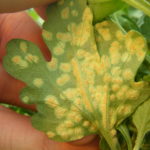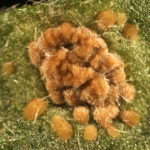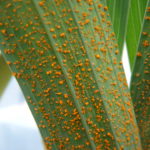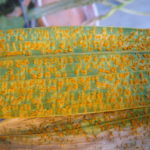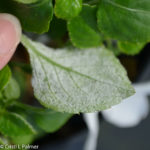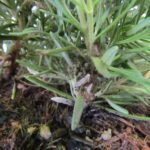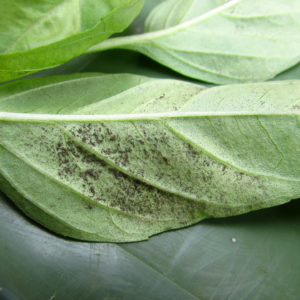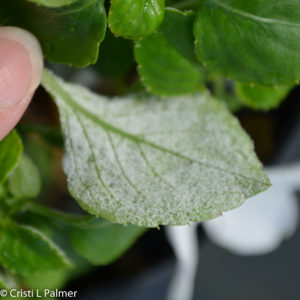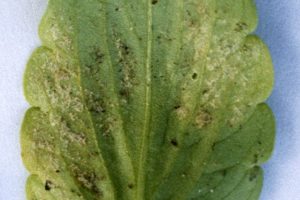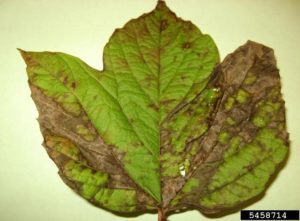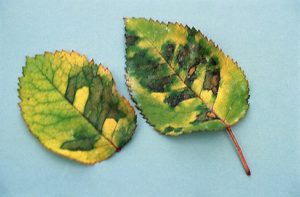IR-4 has coordinated research projects studying mitigation strategies and developing basic knowledge for several invasive species – boxwood blight, chrysanthemum white rust, European pepper moth, gladiolus rust, and impatiens downy mildew.
Outcomes
- Improved management strategies
- Better understanding of environmental parameters for pathogen infection and pest development
- Serological and genetic diagnostic tools
- Increased knowledge of basic biological and genetic characteristics of these pathogens and pests
Project Descriptions
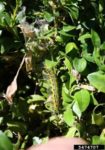
Box Tree Moth
Box tree moth (BTM) was first discovered in the US during 2021 during a trace forward event after a nursery in Canada inadvertently shipped infested boxwoods to 6 states.
Starting in 2020, APHIS sponsored surveys for this pest in select states near the Canadian border – where BTM was discovered in 2018 – and along channels of trade. Research through the Farm Bill to investigate mitigation (management) options and improved lures/traps also began in 2020. Insecticides are being screened by amending BTM feeding media and assessing mortality of eggs through development into 2nd instars.
In 2021, we prepared a mitigation guidance document in response to the limited finds of BTM in three states and then updated it in 2022 it to include commonly found moths in traps deployed to lure BTM adults in surveys to determine spread within the United States.
Research Team
Mr. Dan Gilrein
Dr. Steve Frank
Mr. Matt Havers
Dr. Cristi Palmer
Boxwood Blight
Boxwood blight was first discovered in the US during 2011. Worldwide, this disease is caused by two different closely related fungi: Calonectria pseudonaviculata and Calonectria henricotiae. Today only the first fungus is found in the US.
From 2012 through 2018, APHIS sponsored research through the Farm Bill to investigate mitigation (management) options, basic biology (how the fungus grows and develops), epidemiology (how the pathogen spreads and creates disease), genomics (the genes and relatedness of other fungi), and diagnostics (how to identify this pathogen specifically and quickly).
In February 2017, the American Boxwood Society hosted a meeting where the boxwood blight research team shared research results with growers, landscapers, extension personnel and others.
Research Team
Dr. Anton Baudoin
Dr. Mike Benson
Dr. Len Coop
Dr. JoAnne Crouch
Dr. Mark Cubeta
Mr. Norm Dart
Ms. Margery Daughtrey
Dr. Sharon Douglas
Dr. Ann Brooks Gould
Dr. Chuan Hong
Dr. Kelly Ivors
Dr. Jim LaMondia
Dr. Bob Marra
Dr. Cristi Palmer
Dr. Nina Shishkoff
Dr. Oney Smith
Chrysanthemum White Rust
Chrysanthemum white rust is a disease of chrysanthemums considered a quarantine pest by USDA-APHIS. The pathogen that causes this disease is Puccinia horiana.
From 2011 through 2016, APHIS sponsored research through the Farm Bill to investigate mitigation (management) options, basic biology (how the fungus grows and develops), epidemiology (how the pathogen spreads and creates disease), host range (what other plants closely related to garden mums are susceptible), genetic variability (the similarity of US and European strains), and diagnostics (how to identify this pathogen specifically and quickly).
Research Team
Dr. Mo Bonde
Dr. Bas Brandwagt
Dr. JoAnne Crouch
Dr. Kurt Huengens
Dr. Doug Luster
Dr. Cristi Palmer
Dr. Oney Smith
Gladiolus Rust
Gladiolus rust is a disease of gladiolus and a few related plants like Tritomia. At the time this project started, this disease was considered a quarantine pest by USDA-APHIS, but it has now been determined to be endemic and limited to small geographical area based on spore survival. The pathogen that causes this disease is Uromyces transversalis.
From 2010 through 2014, APHIS sponsored research through the Farm Bill to investigate mitigation (management) options, basic biology (how the fungus grows and develops), cultivar resistance, and diagnostics (how to identify this pathogen specifically and quickly).
Research Team
Dr. Mo Bonde
Dr. James Buck
Dr. Steve Jeffers
Dr. Doug Luster
Dr. Keithanne Mockaitis
Dr. Cristi Palmer
Dr. Oney Smith
Dr. Alberto Valencia-Botin
Impatiens Downy Mildew
Impatiens downy mildew (IDM) was first discovered in the US during 2004. During 2015 through 2007, only sporadic cases occurred. However, during 2009 and 2010, there were major declines in impatiens planting in Saratoga Springs, NY. Then in 2011 and 2012, IDM was reported throughout the US. This disease is caused by an oomycete or water mold called Plasmopara obducesns.
From 2013 through 2017, APHIS sponsored research through the Farm Bill to investigate mitigation (management) options, basic biology (how the fungus grows and develops), epidemiology (how the pathogen may overwinter and then create disease the following spring), genomics (the genes, relatedness of other fungi, and population changes over time), and diagnostics (how to identify this pathogen specifically and quickly).
Research Team
Dr. JoAnne Crouch
Ms. Margery Daughtrey
Dr. Mary Hausbeck
Dr. Cristi Palmer
Dr. Aaron Palmateer
Dr. Lina Quesada
Dr. Nina Shishkoff
Shipping of Arthropods
Accidental movement of insect and mite pests (arthropods) domestically and internationally via shipping of cuttings occurs. While plants are inspected and possibly sequestered for a period of time, it is possible to miss seeing small exotic arthropods or their eggs.
From 2011 through 2014, APHIS sponsored research through the Farm Bill to investigate mitigation (management) options using biopesticides and softer products applied prior to shipping of cuttings of several model crops. Also examined was the use of hot water baths to kill multiple insect and mite stages. Part of this project was developing mitigation options and life cycle information for the newly arrived pest European Pepper Moth (Duponchelia fovealis).
Research Team
Dr. James Bethke
Dr. Arnold Hara
Dr. Lance Osborne
Dr. Cindy McKenzie
Dr. Cristi Palmer


